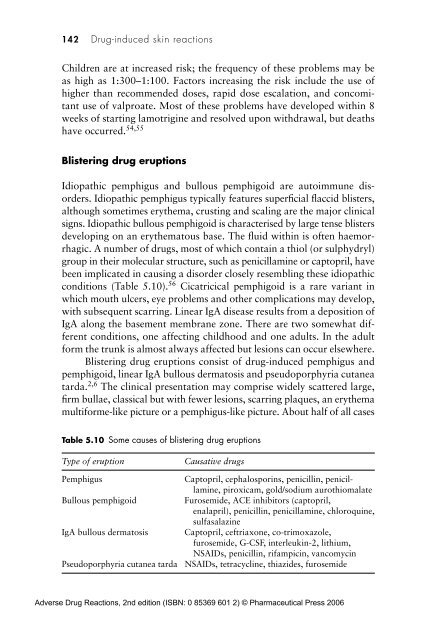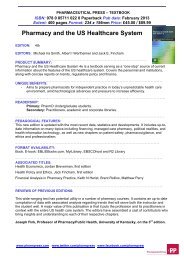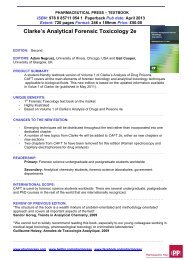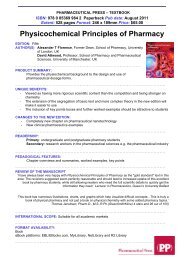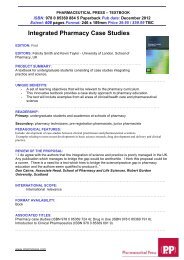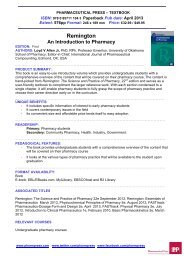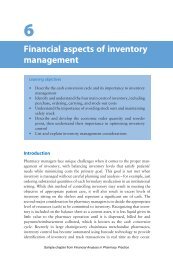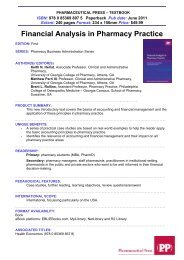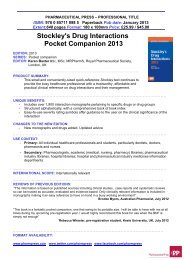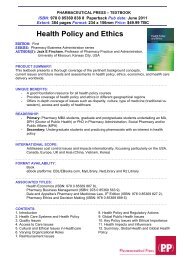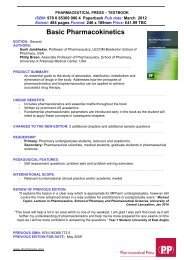Drug-induced skin reactions - Pharmaceutical Press
Drug-induced skin reactions - Pharmaceutical Press
Drug-induced skin reactions - Pharmaceutical Press
Create successful ePaper yourself
Turn your PDF publications into a flip-book with our unique Google optimized e-Paper software.
142 <strong>Drug</strong>-<strong>induced</strong> <strong>skin</strong> <strong>reactions</strong><br />
Children are at increased risk; the frequency of these problems may be<br />
as high as 1:300–1:100. Factors increasing the risk include the use of<br />
higher than recommended doses, rapid dose escalation, and concomitant<br />
use of valproate. Most of these problems have developed within 8<br />
weeks of starting lamotrigine and resolved upon withdrawal, but deaths<br />
have occurred. 54,55<br />
Blistering drug eruptions<br />
Idiopathic pemphigus and bullous pemphigoid are autoimmune disorders.<br />
Idiopathic pemphigus typically features superficial flaccid blisters,<br />
although sometimes erythema, crusting and scaling are the major clinical<br />
signs. Idiopathic bullous pemphigoid is characterised by large tense blisters<br />
developing on an erythematous base. The fluid within is often haemorrhagic.<br />
A number of drugs, most of which contain a thiol (or sulphydryl)<br />
group in their molecular structure, such as penicillamine or captopril, have<br />
been implicated in causing a disorder closely resembling these idiopathic<br />
conditions (Table 5.10). 56 Cicatricical pemphigoid is a rare variant in<br />
which mouth ulcers, eye problems and other complications may develop,<br />
with subsequent scarring. Linear IgA disease results from a deposition of<br />
IgA along the basement membrane zone. There are two somewhat different<br />
conditions, one affecting childhood and one adults. In the adult<br />
form the trunk is almost always affected but lesions can occur elsewhere.<br />
Blistering drug eruptions consist of drug-<strong>induced</strong> pemphigus and<br />
pemphigoid, linear IgA bullous dermatosis and pseudoporphyria cutanea<br />
tarda. 2,6 The clinical presentation may comprise widely scattered large,<br />
firm bullae, classical but with fewer lesions, scarring plaques, an erythema<br />
multiforme-like picture or a pemphigus-like picture. About half of all cases<br />
Table 5.10 Some causes of blistering drug eruptions<br />
Type of eruption<br />
Pemphigus<br />
Bullous pemphigoid<br />
IgA bullous dermatosis<br />
Pseudoporphyria cutanea tarda<br />
Causative drugs<br />
Captopril, cephalosporins, penicillin, penicillamine,<br />
piroxicam, gold/sodium aurothiomalate<br />
Furosemide, ACE inhibitors (captopril,<br />
enalapril), penicillin, penicillamine, chloroquine,<br />
sulfasalazine<br />
Captopril, ceftriaxone, co-trimoxazole,<br />
furosemide, G-CSF, interleukin-2, lithium,<br />
NSAIDs, penicillin, rifampicin, vancomycin<br />
NSAIDs, tetracycline, thiazides, furosemide<br />
Adverse <strong>Drug</strong> Reactions, 2nd edition (ISBN: 0 85369 601 2) © <strong>Pharmaceutical</strong> <strong>Press</strong> 2006


